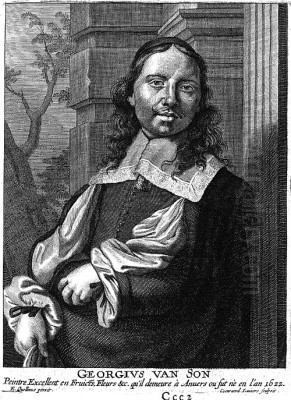
Joris van Son (1623-1667) stands as a significant figure in the rich tapestry of Flemish Baroque art. Active during the vibrant artistic period of 17th-century Antwerp, he carved a distinct niche for himself as a specialist in still life painting. His canvases, often brimming with meticulously rendered fruits, flowers, and luxurious objects, capture the opulence and complex symbolism characteristic of the era. Though perhaps overshadowed in popular recognition by some contemporaries, Van Son's technical skill, compositional ingenuity, and thematic depth secured his place within the esteemed tradition of Antwerp still life painters.
Born into the bustling artistic hub of Antwerp, Van Son entered a world where painting, particularly genres like still life, history painting, and portraiture, flourished. The city, despite political and economic shifts, remained a vital center for artistic production, supported by guilds, patrons, and a discerning market. Van Son's life and career unfolded entirely within this dynamic environment, shaping his artistic sensibilities and providing both inspiration and competition. His legacy lies in his contribution to the specific genres of fruit, flower, banquet (pronkstilleven), and allegorical vanitas still lifes.
Antwerp Beginnings and Artistic Formation
Joris van Son was baptized in Antwerp on September 24, 1623. His parents were Cornelis van Son and Catharina Formenois. Little is documented about his earliest training, but the artistic environment of Antwerp would have provided ample exposure to the works of established masters. The city was home to towering figures like Peter Paul Rubens (though he died in 1640, his influence was pervasive) and Anthony van Dyck (who died in 1641), alongside specialists in various genres. For an aspiring still life painter, the examples set by artists like Osias Beert the Elder, Clara Peeters, and Frans Snyders were particularly relevant.

The pivotal influence on Van Son's development, however, came from Jan Davidszoon de Heem. De Heem, a Dutch painter who had moved to Antwerp around 1635/1636, was a leading master of ornate still life. His works, characterized by their sophisticated compositions, rich colours, and illusionistic textures, set a new standard. Strong stylistic evidence suggests that Van Son either trained directly under De Heem or worked closely within his circle, absorbing his techniques and thematic approaches. This connection is crucial to understanding Van Son's artistic trajectory.
Membership in the Guild of Saint Luke was essential for any artist wishing to practice professionally in Antwerp, take on pupils, or sell works openly. Van Son was registered as a master in the Antwerp Guild in the guild year 1643/1644. This official recognition marked the beginning of his independent career. Records indicate he may have even served as the dean of the Guild for the year 1644/45, although this is sometimes debated, it points towards a relatively swift integration into the city's formal artistic structures.
The Evolution of a Style: Detail, Light, and Luxury
Joris van Son's style is firmly rooted in the Flemish Baroque tradition, emphasizing realism, rich textures, and often, a sense of abundance or drama. His technique involved careful layering of oil paints, often on panel or canvas, achieving remarkable detail in the depiction of surfaces – the dewy skin of a grape, the fuzzy texture of a peach, the reflective gleam of metal, or the delicate translucency of glass. He possessed a keen eye for the effects of light and shadow, using chiaroscuro not just for modeling form but also for creating mood and highlighting specific elements within the composition.
Early works by Van Son sometimes show a more direct adherence to the models provided by Jan Davidszoon de Heem. However, he quickly developed his own distinct manner. While De Heem's compositions could be incredibly complex and overflowing, Van Son often favoured slightly clearer arrangements, sometimes employing diagonal lines or structured groupings to organize the profusion of objects. His colour palette, while rich, could also incorporate softer tones and subtle contrasts, contributing to a sense of refined elegance.
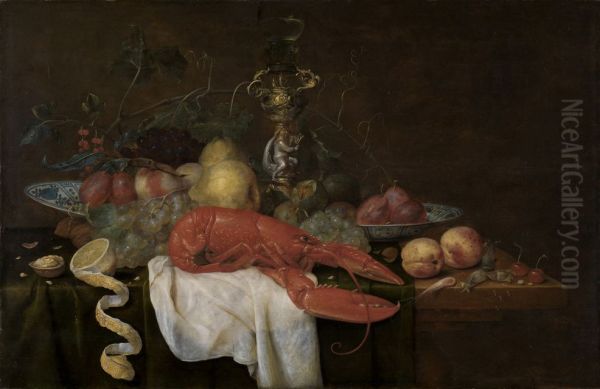
Over time, some art historians note a potential shift in his style, perhaps moving slightly away from the high Baroque exuberance towards elements associated more with Dutch still life – a greater emphasis on tonal harmony or a more restrained composition in certain works. However, he remained fundamentally a Flemish painter, consistently drawn to the depiction of luxurious items and intricate arrangements that appealed to the tastes of Antwerp patrons. His ability to render diverse textures – fruit, flowers, silverware, porcelain, textiles – side-by-side with convincing realism was a hallmark of his skill.
Themes and Symbolism: More Than Meets the Eye
While visually appealing, Van Son's still lifes were rarely mere decorations. Like much of Baroque art, especially in the context of the Counter-Reformation which strongly influenced Flanders, his works are often imbued with layers of symbolic meaning. He excelled in several sub-genres of still life, each carrying its own potential for interpretation.
Fruit and flower pieces were common. Beyond their beauty, specific items often carried traditional symbolism. Grapes could allude to the Eucharist (Christ's blood), while apples might recall the Fall of Man. Peaches symbolized truth or salvation, and cherries, the fruits of Paradise or the sweetness of virtue. Flowers, too, had their language: roses for love or martyrdom, tulips (often associated with speculation and transience after the Dutch 'Tulip Mania') for vanity or the fleeting nature of beauty, lilies for purity. Insects like butterflies could represent resurrection or the soul, while flies or decaying elements served as reminders of mortality.
Van Son was also adept at pronkstillevens, or ostentatious still lifes. These paintings showcased expensive objects – imported porcelain, elaborate glassware (like Venetian-style façon de Venise), silver or gold vessels, luxurious fabrics, and exotic foods like lobsters and oysters. Such works celebrated wealth and worldly pleasures but often contained subtle warnings against excess or reminders of the ultimate vanity of earthly possessions. They reflected the prosperity of Antwerp's merchant class while simultaneously engaging with moral or religious undertones.
The vanitas theme was particularly prominent in Van Son's oeuvre. These allegorical still lifes directly addressed the transience of life, the futility of pleasure, and the certainty of death. Common vanitas symbols featured prominently in his work include skulls (the most direct symbol of death), extinguished or guttering candles (life burning away), hourglasses or clocks (the passage of time), soap bubbles (the brevity and fragility of life, homo bulla – man is a bubble), musical instruments (the fleeting nature of pleasure), and wilting flowers or decaying fruit. These paintings served as moral reminders, urging viewers to contemplate spiritual matters over worldly concerns.
Garland Paintings: Collaboration and Devotion
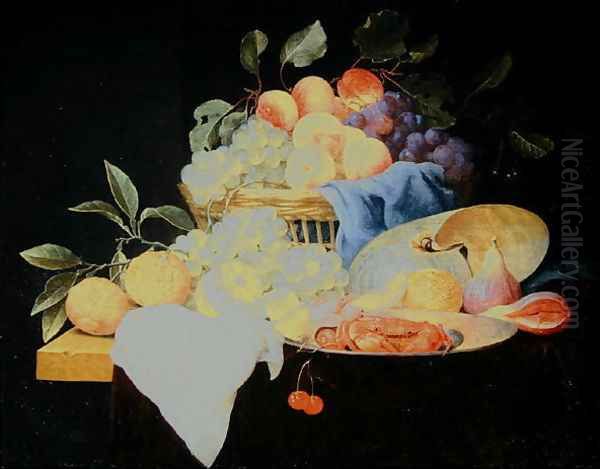
A distinctive genre in which Van Son participated was the 'garland painting' (guirlande). This type of devotional image was particularly popular in Antwerp and is strongly associated with artists like Jan Brueghel the Elder and Hendrick van Balen, and later perfected by the Jesuit painter Daniel Seghers. These paintings typically feature a central image, often a religious scene, portrait, or symbol (like the Host), surrounded by a lush garland of flowers, fruit, or a combination of both.
The creation of garland paintings often involved collaboration between two specialists: a figure painter for the central motif and a still life painter for the surrounding garland. While Van Son was primarily a still life specialist, he is known to have created garland paintings. In some cases, he might have painted the entire work, including a grisaille (monochromatic) central image, or he may have collaborated with figure painters. Artists like Erasmus Quellinus II or Cornelis Schut were known contemporaries who engaged in such collaborations.
The garlands themselves were not merely decorative. The flowers and fruits often carried specific symbolic meanings related to the central devotional image. For instance, flowers surrounding the Virgin Mary might emphasize her purity (lilies) or sorrows (columbines), while fruits could symbolize the bounty of salvation. Van Son's skill in rendering these elements with vibrant realism and symbolic resonance made him well-suited to this genre. His contributions helped perpetuate this unique Antwerp tradition, blending decorative beauty with profound religious sentiment.
Analysis of Key Works
Several works exemplify Joris van Son's style and thematic concerns. His Still Life with Fruit, Wheat, and Corn showcases his ability to create a sense of abundance and naturalism. The varied textures of the fruits, the delicate rendering of the wheat stalks, and the interplay of light create a visually rich composition. The inclusion of wheat and grapes likely carries Eucharistic connotations, adding a layer of religious meaning to the depiction of natural bounty.
The painting titled Still Life with Fruit, described as having fruits divided into symbolic groups (Paradise, truth, fertility), highlights his intentional use of symbolism. This structured approach within an apparently casual arrangement demonstrates a sophisticated compositional mind at work, guiding the viewer's interpretation beyond simple appreciation of the objects depicted.

His Allegory of Human Life (circa 1658-1660) is a powerful example of a vanitas integrated into a garland format. The central elements – a skull crowned with wheat (symbolizing death and resurrection or the cycle of life), an extinguished candle, a watch, soap bubbles, and perhaps musical scores – are potent symbols of mortality and the fleeting nature of time and earthly achievements. These are encircled by a vibrant garland of fruits and flowers, creating a poignant contrast between transient life and enduring beauty, or perhaps suggesting that even beauty is subject to decay. The technical execution, balancing the macabre center with the lush periphery, is masterful.
Another work, Three Putti with Vanitas Symbols, employs classical figures (putti, often associated with innocence or the secular) within a vanitas context. The juxtaposition of the cherubic figures with symbols of death like skulls and shells creates a complex allegorical statement, perhaps commenting on the vulnerability of life or the vanity inherent even in seemingly innocent pleasures. This blending of figure painting elements (even if minor) with still life underscores the fluidity between genres in the Baroque period.
The Workshop, Students, and Influence
Like most successful masters of his time, Joris van Son likely maintained a workshop and trained apprentices. The master-apprentice system was the standard method for artistic education. Apprentices would learn by copying the master's work, grinding pigments, preparing panels, and gradually contributing to paintings before eventually becoming independent masters themselves.
Several painters are recorded as having been pupils of Joris van Son. These include Frans van Everbroeck, Jan Pauwael Gillemans the Younger, Cornelis van Huyn, Norbertus van Herp (a versatile painter also known for genre scenes), and Abraham de Harduwijn (or Herderwijn). Jan Pauwael Gillemans the Younger, in particular, became a notable still life painter in his own right, clearly showing the influence of Van Son's style in his detailed fruit and flower pieces.
The training provided in Van Son's workshop would have emphasized the meticulous techniques required for high-realism still life, compositional principles, and likely, an understanding of the symbolic language embedded within the genre. Through his students, Van Son's specific approach to still life painting was disseminated, contributing to the continuity of the Antwerp tradition. It is important to note that while collaboration was common, the suggestion sometimes seen that the major figure painter Anthony van Dyck was a student is chronologically impossible; Van Dyck was an established international artist who died when Van Son was just beginning his independent career.
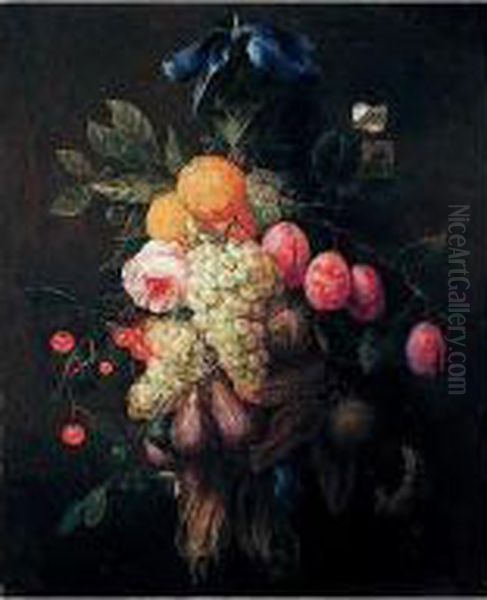
Van Son's influence extended beyond his direct pupils. His works, circulating in the Antwerp market and beyond, would have been seen and studied by other artists. He contributed to the high standards of technical excellence and the ongoing popularity of still life, particularly fruit pieces and vanitas themes, within Flemish art of the mid-17th century.
Context, Contemporaries, and Reputation
Joris van Son worked during a period of intense artistic activity in Antwerp. While the city's political and economic dominance had waned somewhat from its peak in the 16th century, it remained a major European art center. The demand for paintings, fueled by the Church, the aristocracy, and increasingly, the wealthy bourgeoisie, supported a large number of artists specializing in different genres.
In the field of still life, Van Son operated alongside other talented Flemish painters. Frans Snyders was a master of large-scale market scenes and hunting still lifes, often collaborating with Rubens. Adriaen van Utrecht was another prominent figure known for his lavish banquet pieces and market scenes. Jan Fyt excelled in depicting game and hunting trophies with remarkable textural realism. While their specializations sometimes differed, these artists formed part of the competitive yet interconnected artistic community in which Van Son thrived.
His relationship with Jan Davidszoon de Heem remained significant throughout his career, representing both a source of inspiration and a benchmark of quality. He also would have been aware of developments in Dutch still life painting, exemplified by artists like Willem Kalf (known for luxurious pronkstillevens), Pieter Claesz, and Willem Claeszoon Heda (masters of monochrome banquet pieces). While distinct national styles existed, there was considerable cross-pollination, especially with De Heem working in Antwerp.
Despite the popularity and technical brilliance of still life, the genre was often considered lower in the theoretical hierarchy of genres than history painting (depicting biblical, mythological, or historical scenes). This hierarchy, derived from Renaissance art theory, placed the depiction of the human figure engaged in significant action at the top. The Dutch writer and painter Samuel van Hoogstraten famously referred to still life painters as mere "foot soldiers in the army of art." While perhaps reflecting a theoretical bias, this did not necessarily diminish the commercial success or appreciation of skilled still life painters like Van Son among patrons and collectors.
Market, Collections, and Legacy
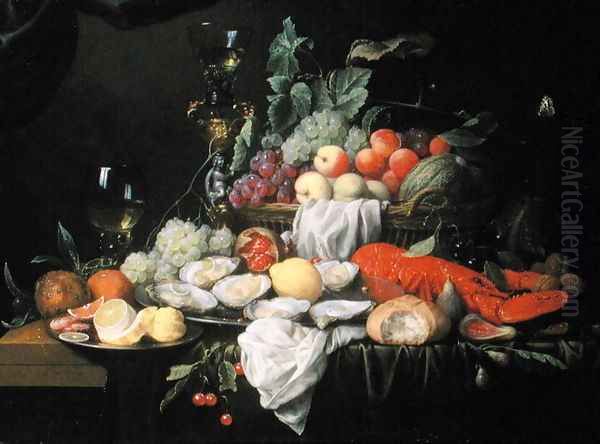
During his lifetime, Joris van Son's paintings found a ready market among Antwerp's citizenry and possibly international collectors. The demand for decorative and symbolic still lifes was strong. After his death in Antwerp in 1667, his reputation endured. His works continued to be collected and appreciated for their technical finesse and appealing subject matter.
In the centuries since, Van Son's paintings have entered numerous public and private collections across Europe and beyond. Museums holding his works include prestigious institutions like the Prado Museum in Madrid, the Rijksmuseum in Amsterdam, the Ashmolean Museum in Oxford, and the Royal Museums of Fine Arts of Belgium in Brussels, among others. The presence of his work in these collections attests to his historical significance.
On the art market, Joris van Son's paintings appear regularly at auction. Prices can vary significantly depending on factors such as size, condition, subject matter, provenance, and overall quality. Well-preserved, characteristic works, particularly elaborate fruit pieces or compelling vanitas compositions, can command substantial sums, often reaching tens of thousands of Euros or dollars. For example, a Still Life with Vanitas was noted to have an estimate of €30,000-€40,000 at a Dorotheum auction in 2024. Other works, perhaps smaller or less complex, might trade at lower price points, but his status as a recognized Old Master ensures continued collector interest.
Joris van Son's legacy lies in his contribution to the Flemish Baroque still life tradition. He masterfully combined meticulous realism with complex symbolism, creating works that were both visually stunning and intellectually engaging. He absorbed the influence of the great Jan Davidszoon de Heem but forged his own recognizable style, characterized by careful composition, sensitivity to light and texture, and a particular aptitude for fruit pieces and vanitas themes.
His participation in the genre of garland paintings further highlights his versatility and integration into Antwerp's specific artistic practices. Through his own works and those of his pupils, particularly Jan Pauwael Gillemans the Younger, he helped shape the course of still life painting in the Southern Netherlands during a vibrant period.
Conclusion: An Enduring Vision
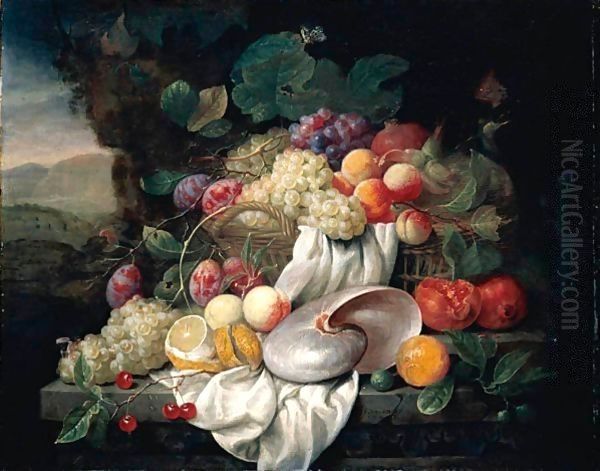
Joris van Son represents the quintessential Flemish Baroque still life painter: technically brilliant, thematically rich, and deeply embedded in the artistic culture of 17th-century Antwerp. From his probable training with Jan Davidszoon de Heem to his successful independent career and the training of his own pupils, he played a vital role in the development and dissemination of the genre. His paintings, whether celebrating the bounty of nature, reflecting on the vanity of human existence, or framing devotional images with floral splendor, continue to captivate viewers with their intricate detail, luminous quality, and enduring symbolic power. He remains a testament to the depth and diversity of talent that flourished in Antwerp's Golden Age of painting.